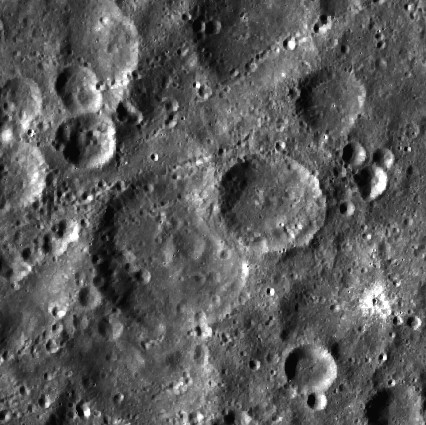Denning
Contents
Denning
| Lat: 16.4°S, Long: 142.6°E, Diam: 44 km, Depth: km, Rükl: (farside) |


left: LOI-115-M . right: LROC . Denning is the right crater of the center pair, protruding into satellite R east rim. There are long chains of secondaries from Tsiolkovskiy crater, located 400 km to SE.
Images
LPOD Photo Gallery Lunar Orbiter Images Apollo Images
- AS8-13-2328, made during the mission of Apollo 8, shows a bright ray-craterlet with 270° (three-fourths) ejectablanket around it, located at 139° East/ 15°20' South, near crater Denning V.
HiRes-scan Apollo 8 photograph and research: David Woods and Frank O'Brien (Apollo 8 Flight Journal).
Additional research: Danny Caes
Maps
(LAC zone 102B1) USGS Digital Atlas PDF
Description
Description: Wikipedia
Additional Information
Lunar Orbiter 1 frame 115-h3 shows an unnamed chain of depressions running diagonally through the photograph, and also through the interior of Denning Y. - DannyCaes Mar 11, 2014
Nomenclature
William Frederick Denning (November 25, 1848 – June 9, 1931) was a British astronomer. He devoted a great deal of time to searching for comets, and discovered several including the periodic comet 72P/Denning-Fujikawa and the lost comet D/1894 F1. The latter was the last comet discovered on British soil until the discoveries of George Alcock.
Were Denning's odd observations of so-called sleeks (swift nearby meteors, darting gleams of light) perhaps related to the psychological phenomenon known as Prisoner's Cinema? (see also Denning's articles in the Sourcebook Project, William R. Corliss).
LPOD Articles
Bibliography
- About William F. Denning himself:
- Comets, Meteorites, and Men (Peter Lancaster Brown).
William F. Denning in the Sourcebook Project (William R. Corliss)
- In Lightning, Auroras, Nocturnal Lights, and related luminous phenomena (1982) :
- GLA11-R1: The Meteoric Streak of February 22 (W.F.Denning, Nature, 1909). GLA11: Auroras correlated with Meteors.
- GLA16-R7: Aurora Borealis and Gales (W.F.Denning, English Mechanic, 1872). GLA16: Weather Lights or Storm Lights.
- GLM2-R1: A Peculiar Variety of Meteors (W.F.Denning, Monthly Notices of the Royal Astronomical Society, 1885). GLM2: Darting Gleams of Light.
- GLM2-R2: A Curious Variety of Meteor (W.F.Denning, Popular Astronomy, 1914).
- In Tornados, Dark Days, Anomalous Precipitation, and related weather phenomena (1983) (Giant Snowflakes) :
- Large Snow Flakes (Symons's Meteorological Magazine, 1912)
- In Earthquakes, Tides, Unidentified Sounds, and related phenomena (1983) (Hissing and Buzzing Sounds Correlated with High-Altitude Meteors) :
- Great Detonating Fireball Seen in Sunshine (Knowledge, 1902)
- On the Sounds Alleged to Precede or Accompany the Flights of Meteors (Journal of the British Astronomical Association, 1903)
- Audible Meteors (Symons's Meteorological Magazine, 1907)
- In Mysterious Universe; a handbook of Astronomical Anomalies (1979) :
Articles by W.F.Denning himself:
- Page 50: Planetary Spots Passing over the Sun (Astronomical Register, 1871) (the Intra-Mercurial Planet).
- Page 267: A Peculiar Variety of Meteors (Monthly Notices of the Royal Astronomical Society, 1884).
- Page 285: The Long Durations of Meteoric Radiant Points (Nature, 1885).
- Page 287: The Stationary Radiation of Meteors (Observatory, 1913).
- Page 486: White Spot on Saturn (Scientific American, 1903).
Articles in which W.F.Denning is mentioned:
- Page 73: The Blunted Cusp Effect and Terminator Irregularities (on Mercury) (Dale P. Cruikshank, Strolling Astronomer, 1963).
- Page 110: Illusions (E.M.Antoniadi, Journal of the British Astronomical Association, 1897).
- Page 269: Notes on an Erratic Meteor (B.J.Hopkins, Monthly Notices of the Royal Astronomical Society, 1886).
- Page 283: Transit of a Dark Body across the Moon's Disc (W.H.Steavenson, Journal of the British Astronomical Association, 1920).
- Page 364: The Zodiacal Band (R.B.Bousfield, Monthly Notices of the Royal Astronomical Society, 1934).
- Page 435: Periodic Disturbances in the Northern Hemisphere of Jupiter (Stanley A. Williams, Observatory, 1900).
- Page 476: The White Spot on Saturn's Rings (Hugh M. Johnson, Journal of the British Astronomical Association, 1941).